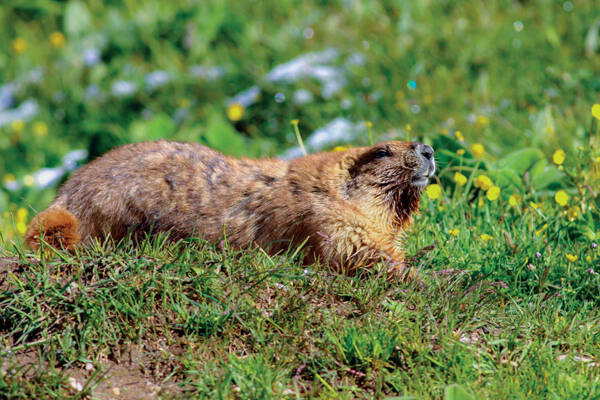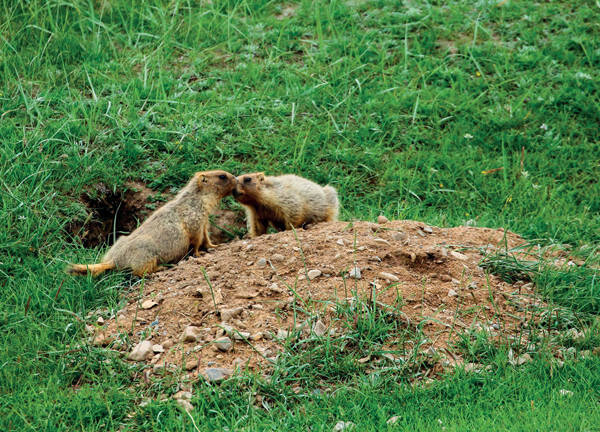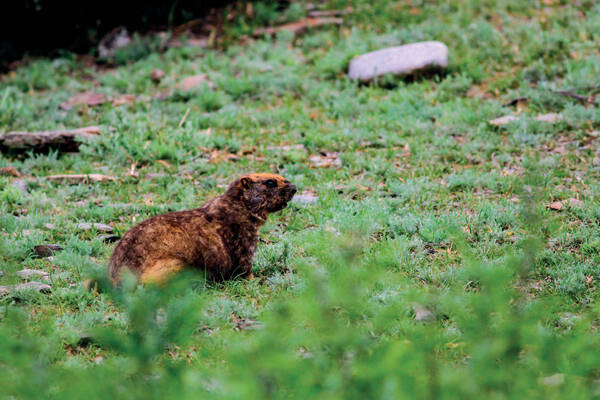Marmota baibacina
IUCN
LCBasic Information
Scientific classification
- name:Marmota baibacina
- Scientific Name:Marmota baibacina,Altai Marmot,Tianshan marmot, Altai marmot
- Outline:Rodents
- Family:Rodentia Sciuridae Marmota
Vital signs
- length:400~580mm
- Weight:3-7.5kg
- lifetime:
Feature
It has a short and thick body, long and soft fur, and the fur on the back is sandy yellow or sandy brown.
Distribution and Habitat
In China, it is only distributed in Fuhai, Hefeng, Tacheng, Bole, Zhaosu, Xinyuan, Nileke, Jinghe, Shawan, Manas, Yutubi, Changji and Urumqi in Xinjiang. Abroad, it is distributed in Mongolia, Russia, Kazakhstan and Kyrgyzstan.
It mainly lives in mountainous grassland environments with gentle slopes.
Appearance
The body is stout, with long and soft fur. The snout is dark brown. The back of the body is beige or sandy yellow, with black or dark brown ripples. The fur on the ventral side of the body is darker, reddish brown or dark reddish brown with a yellow tint. The color of the dorsal and ventral sides of the tail is similar to that of the dorsal and ventral sides of the body. The skull is relatively wide. A sharp wedge-shaped notch is formed in the middle of the rear end of the nasal bone.
Details
The gray marmot (scientific name: Marmota baibacina), also known as the Tianshan marmot and the Altai marmot, is a large terrestrial rodent mammal belonging to the order Rodentia, the family Sciuridae, and the genus Marmota. The gray marmot is a typical grassland rodent, mainly inhabiting places with dense vegetation in alpine meadows, forest grasslands and mountain grasslands. The upper limit of vertical distribution is 3700m above sea level, and the lower limit is 1200m. Its tunnels are mostly dug on rocky slopes or under the bushes on both sides of the valleys of relatively humid alpine grasslands. It especially likes to live on sunny slopes and open mountain plains. In areas with lower altitudes, it mainly inhabits relatively humid windward slopes.

The gray marmot has a relatively simple diet. In summer, it mainly eats the green parts of various grasses in the Gramineae, Cyperaceae, and Leguminosae families. It digs and eats grass roots when it comes out of hibernation in early spring, and also eats a small amount of insects in autumn. In human cages, it likes to eat dandelion flowers and various vegetables. The gray marmot has a large appetite, and the stomach weight after eating can reach 200~300g.
The gray marmot is a typical true hibernator. It sleeps in caves for more than half a year and is active on the ground for only 5 to 5.5 months. There are no obvious external signals for its coming out of hibernation and entering hibernation. Generally speaking, it starts to come out of hibernation when the snow melts, plants sprout and the temperature stabilizes above 0℃, and the time of entering hibernation is roughly the same as when the plants turn yellow, snow falls and the temperature approaches zero degrees Celsius. The marmots in the Tianshan Mountain Meadow Steppe Zone and Mountain Steppe generally start to come out of hibernation in early March; the time of coming out of hibernation in the alpine and subalpine meadow steppe zones is 10 to 15 days later than the above two vegetation zones.

The gray marmot camp lives in a family-style group cave. One cave is a family, and a family has several marmots. The size of the cave group varies depending on the time it is used. There are two types of gray marmot caves: one is a temporary cave, which is short, shallow and simple; the other is a winter cave, which is 2-3m deep, complex and has many branches. It is diurnal and generally moves within 30-50m of the cave during the day. Gray marmots are typical daytime activities. In summer, the time of going out of the cave and activity is roughly consistent with sunrise, sunset and the time when the cave entrance is directly exposed to sunlight. However, the peak of activity is a period of 3 hours after sunrise and before sunset (double peak type). They return to the cave to rest around the hot noon. In early spring and late autumn, the temperature is lower in the morning and evening, so they often go out of the cave to the ground at noon (single peak type).
Gray marmots reproduce once a year and produce one litter of pups per year. They reach sexual maturity late and need to hibernate twice or three times to reach sexual maturity. After coming out of hibernation, they enter the mating period, and give birth in large numbers in mid-to-late April. The gestation period is 35 to 40 days, with 1 to 13 pups per litter, of which 4 to 9 pups are the most, with an average of 6.15 pups, and a female-to-male ratio of 1:1.15. The lactation period is about 30 days, and the young marmots begin to appear on the ground in early May (mountain grassland zone) or late May or early June (alpine and subalpine meadow zone).

The fur of the gray marmot is thick and strong, with dense and shiny fur, which can be used to make fur coats; the guard hair is flat and the fluff is rich, which is suitable for making clothes and hats; the tail hair and guard hair are rigid, which is the best raw material for making high-grade paintbrushes.
The gray marmot is a kind of animal with both benefits and harms. The gray marmot's habitat is mostly excellent natural spring and summer pastures. It destroys vegetation, competes with livestock for fodder, and is also a natural host of plague. The gray marmot is the main host animal of the Tianshan forest grassland, alpine grassland gray marmot, and long-tailed yellow squirrel plague foci. It is also an important storage host of the Tianshan mountain plague foci in Kazakhstan and Kyrgyzstan. The gray marmot is also a carrier of pathogens of erysipelas, forest encephalitis, pseudotuberculosis, lancelet trematode disease, Q fever, leptospirosis, and toxoplasmosis.








